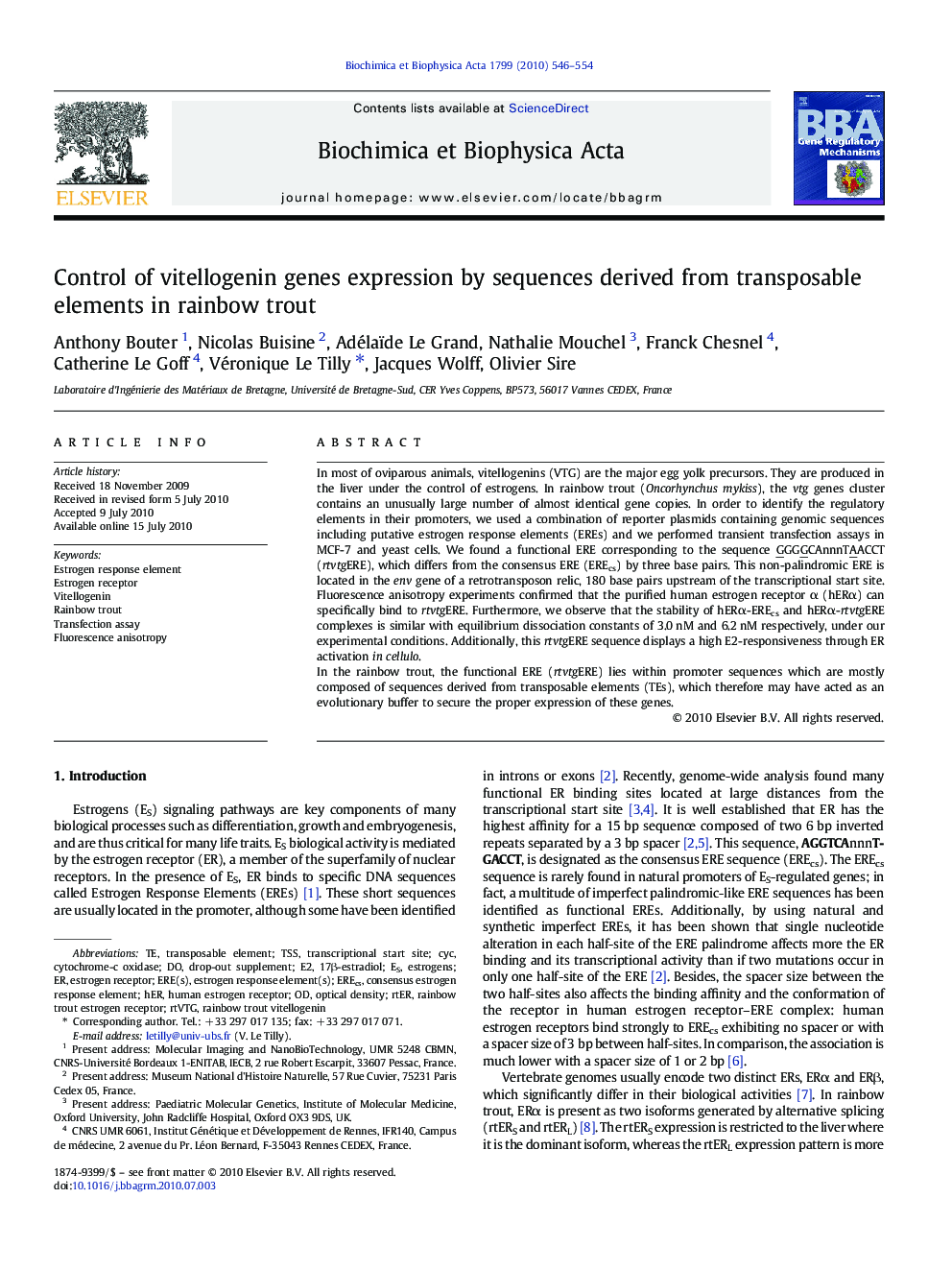| Article ID | Journal | Published Year | Pages | File Type |
|---|---|---|---|---|
| 1946816 | Biochimica et Biophysica Acta (BBA) - Gene Regulatory Mechanisms | 2010 | 9 Pages |
In most of oviparous animals, vitellogenins (VTG) are the major egg yolk precursors. They are produced in the liver under the control of estrogens. In rainbow trout (Oncorhynchus mykiss), the vtg genes cluster contains an unusually large number of almost identical gene copies. In order to identify the regulatory elements in their promoters, we used a combination of reporter plasmids containing genomic sequences including putative estrogen response elements (EREs) and we performed transient transfection assays in MCF-7 and yeast cells. We found a functional ERE corresponding to the sequence GGGGCAnnnTAACCT (rtvtgERE), which differs from the consensus ERE (EREcs) by three base pairs. This non-palindromic ERE is located in the env gene of a retrotransposon relic, 180 base pairs upstream of the transcriptional start site. Fluorescence anisotropy experiments confirmed that the purified human estrogen receptor α (hERα) can specifically bind to rtvtgERE. Furthermore, we observe that the stability of hERα-EREcs and hERα-rtvtgERE complexes is similar with equilibrium dissociation constants of 3.0 nM and 6.2 nM respectively, under our experimental conditions. Additionally, this rtvtgERE sequence displays a high E2-responsiveness through ER activation in cellulo.In the rainbow trout, the functional ERE (rtvtgERE) lies within promoter sequences which are mostly composed of sequences derived from transposable elements (TEs), which therefore may have acted as an evolutionary buffer to secure the proper expression of these genes.
Research highlights►“Control of vitellogenin genes expression by sequences derived from transposable elements in rainbow trout” by Anthony Bouter, Nicolas Buisine, Adélaïde Le Grand, Nathalie Mouchel, Jacques Wolff, Olivier Sire and myself. ► In this work, we used a set of in vitro and in cellulo experiments to identify and characterize the estrogen responsive element (ERE) driving the expression of vitellogenin genes. Our key findings are that this ERE significantly differs from the canonical element and that it is located in sequences derived from transposable elements. These have important functional, physiological and evolutionary implications. ► Functionally, we found that the rainbow trout estrogen receptor, a transcription factor belonging to the super family of nuclear receptors, induces a strong estrogen-independent transcriptional activity with canonical EREs. In contrast, the receptor displays a nice estrogen-dependent activity when acting upon the ERE controling vitellogenin genes. These results fit extremely well with the physiology of vitellogenesis. Vitellogenin genes are expressed at extremely high levels and constitutive expression expression would mobilize considerable resources. This will be very likely severely counter-selected. Although not new, this is a very nice illustration that although canonical EREs drive the highest levels of transcription, their physiological relevance is less than that of naturally occurring (and imperfect) EREs. ► The functional (transcriptional) impact of transposable elements has been increasingly recognized as a central evolutionary force promoting the evolution of gene regulation. Indeed, at the cellular and organism level, most of the physiological and phenotypical diversity among vertebrates underlies the diversity of their transcriptional programs rather than their gene content (which is fairly constant). Strikingly, in the case of vitellogenin genes in rainbow trout, transposable elements' activity has dramatically re-shaped the locus: the ancestral promoter has been (almost entirely) replaced by transposable elements, now governing their expression. However, and this is a crucial aspect of our paper, the regulation of vitellogenin genes expression has remained unchanged. Thus, instead of promoting the evolution of gene expression, they had an opposite fate. As stated in our manuscript, and given the potentially devastating effect of ectopic vitellogenin expression, “transposable elements provided both the plague and the cure”. This is a new finding which highlights a new facet to the complex biology of transposable elements, too often perceived as ‘simple’ genomic parasites or typical examples of “selfish DNA”.
